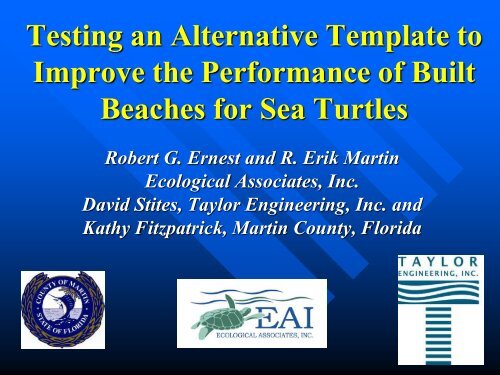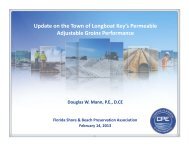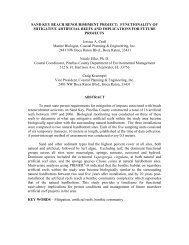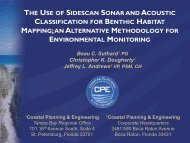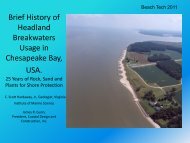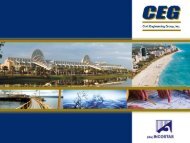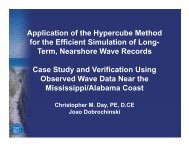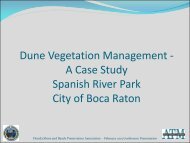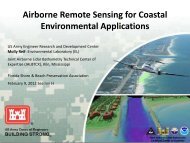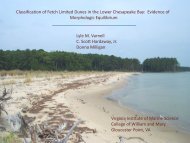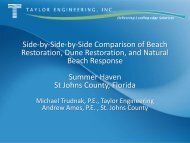Testing an Alternative Template to Improve the Performance ... - fsbpa
Testing an Alternative Template to Improve the Performance ... - fsbpa
Testing an Alternative Template to Improve the Performance ... - fsbpa
You also want an ePaper? Increase the reach of your titles
YUMPU automatically turns print PDFs into web optimized ePapers that Google loves.
<strong>Testing</strong> <strong>an</strong> <strong>Alternative</strong> <strong>Template</strong> <strong>to</strong><br />
<strong>Improve</strong> <strong>the</strong> Perform<strong>an</strong>ce of Built<br />
Beaches for Sea Turtles<br />
Robert G. Ernest <strong>an</strong>d R. Erik Martin<br />
Ecological Associates, Inc.<br />
David Stites, Taylor Engineering, Inc. <strong>an</strong>d<br />
Kathy Fitzpatrick, Martin County, Florida
Hutchinson Isl<strong>an</strong>d
Hutchinson<br />
Isl<strong>an</strong>d<br />
‣ FPL St. Lucie Pl<strong>an</strong>t –<br />
moni<strong>to</strong>ring<br />
requirements - 1971<br />
‣ Subst<strong>an</strong>tial nesting<br />
documented<br />
‣ INBS program - 1989
LOGGERHEAD<br />
GREEN TURTLE
LEATHERBACK
Beach Nourishment<br />
Beach Nourishment is Preferable<br />
<strong>to</strong> Shoreline Armoring<br />
Tourism Drives Florida’s Economy<br />
<strong>an</strong>d Beaches are <strong>the</strong> Primary<br />
Tourist Attraction
Beach Nourishment in Florida<br />
‣825 miles of s<strong>an</strong>dy beaches in Florida<br />
‣60% experiencing some form of erosion<br />
(critical vs. non-critical)<br />
‣218 miles critically eroded in 1989<br />
‣399 miles critically eroded in 2011<br />
‣Sea level rise = more critically eroded<br />
beaches
Effects of Beach Nourishment<br />
on Sea Turtles<br />
‣Crain et al., 1995 – Reviewed effects<br />
<strong>an</strong>d identified research initiatives<br />
‣Nesting <strong>an</strong>d reproductive success<br />
‣Reduction in nesting success<br />
• Increased sediment compaction<br />
• Increased scarping<br />
‣Mixed results for reproductive success
Control<br />
St. Lucie County<br />
Martin County<br />
North Treatment<br />
Atl<strong>an</strong>tic Oce<strong>an</strong><br />
South<br />
Treatment<br />
Beach Nourishment<br />
Area
Difference in Nesting Success (Percent)<br />
1981<br />
1982<br />
1983<br />
1984<br />
1985<br />
1986<br />
1987<br />
1988<br />
1989<br />
1990<br />
1991<br />
1992<br />
1993<br />
1994<br />
1995<br />
1996<br />
1997<br />
1998<br />
1999<br />
2000<br />
Treatment Comparison<br />
of Nesting Success<br />
30<br />
20<br />
Treatments > Control<br />
10<br />
0<br />
-10<br />
-20<br />
North Treatment<br />
South Treatment<br />
Control > Treatments<br />
-30
Role of Beach Profile<br />
Nourished Beach<br />
Natural Beach
Distribution Of Nests Among<br />
Survey Sections - 1996<br />
100<br />
90<br />
80<br />
Beach Width<br />
50<br />
45<br />
40<br />
Number of Nests<br />
70<br />
60<br />
50<br />
40<br />
30<br />
35<br />
30<br />
25<br />
20<br />
15<br />
Beach Width (m)<br />
20<br />
10<br />
10<br />
5<br />
0<br />
Control<br />
North Treatment<br />
South Treatment<br />
0
Spatial Distribution of Nests
Nest Loss <strong>to</strong> Erosion<br />
Nests Lost During Profile<br />
Equilibration<br />
• Sea Turtle Nests<br />
Equilibration<br />
Equilibrium Adjustment
Summary of Effects<br />
‣ Proportionately fewer turtles nest on newly<br />
built beaches<br />
• Reduced nesting success <strong>an</strong>d/or<br />
• Fewer turtles emerging on beach<br />
‣ Increased scarping<br />
‣ Displacement of loggerhead nests<br />
• Increased nest loss <strong>to</strong> erosion<br />
‣ Increased rate of hatchling disorientations<br />
• Higher elevations
Agencies Address Issue<br />
of Beach Shape<br />
‣ 2000 – USFWS convenes interagency<br />
workshop <strong>to</strong> review permit conditions –<br />
recognition of need <strong>to</strong> evaluate alternative<br />
designs<br />
‣ 2001 – FDEP convenes CETAC <strong>to</strong> assess<br />
methods for improving <strong>the</strong> design, permitting<br />
<strong>an</strong>d construction of beach res<strong>to</strong>ration/<br />
nourishment projects
Developing <strong>an</strong> <strong>Alternative</strong><br />
<strong>Template</strong><br />
‣ 2003 – FDEP contracts PBSJ (Atkins)<br />
• Identify aspects of traditionally built beaches that<br />
negatively or positively affect sea turtles<br />
• Provide recommendations for alternative design<br />
criteria <strong>to</strong> improve <strong>the</strong> quality of nesting habitat<br />
‣ Technical Advisory Group (TAG)<br />
• Review <strong>an</strong>d comment on work products<br />
• Develop moni<strong>to</strong>ring pro<strong>to</strong>col for testing <strong>an</strong><br />
alternative template<br />
• Identify test sites
Turtle-friendly Design<br />
‣ Depress cross-sectional profile <strong>to</strong>ward<br />
equilibrium state<br />
‣ Maintain equivalent volume of<br />
nourishment s<strong>an</strong>d in active beach system<br />
<strong>to</strong> maintain shore protection benefits<br />
‣ Physical <strong>an</strong>d environmental constraints –<br />
one size may not fit all
Hutchinson Isl<strong>an</strong>d
Traditional vs. <strong>Alternative</strong> <strong>Template</strong><br />
49 cy/ft
Experimental<br />
Design<br />
8 Cells – 2,000 ft long<br />
700 ft tr<strong>an</strong>sition areas<br />
between cells<br />
Alternating templates<br />
Project construction<br />
winter 2012/2013
Moni<strong>to</strong>ring – RTK GPS<br />
‣ Seaward edge of <strong>the</strong> ascending path<br />
‣ Previous high tide line<br />
‣ Each noticeable ch<strong>an</strong>ge in slope (grade<br />
break)<br />
‣ Base <strong>an</strong>d <strong>to</strong>p of <strong>an</strong>y scarp encountered<br />
‣ Location of each ab<strong>an</strong>doned digging attempt<br />
‣ Clutch location<br />
‣ Crawl apex<br />
‣ Seaward edge of <strong>the</strong> descending path
Moni<strong>to</strong>ring<br />
‣ Upl<strong>an</strong>d feature l<strong>an</strong>dward of <strong>the</strong> clutch or<br />
crawl apex (false crawl)<br />
‣ Light Detection <strong>an</strong>d R<strong>an</strong>ging (LiDAR) data<br />
• Dist<strong>an</strong>ce<br />
• Inclination<br />
‣ Hatchling orientation<br />
‣ St<strong>an</strong>dard data
Objectives<br />
‣ Statistical comparisons using baseline<br />
<strong>an</strong>d treatments<br />
• Nesting success<br />
• Nest placement<br />
• Scarping<br />
• Hatchling disorientations<br />
‣ Technology tr<strong>an</strong>sfer<br />
‣ Opportunities for Collaboration<br />
www.Ecological-Associates.com
Th<strong>an</strong>k You!


